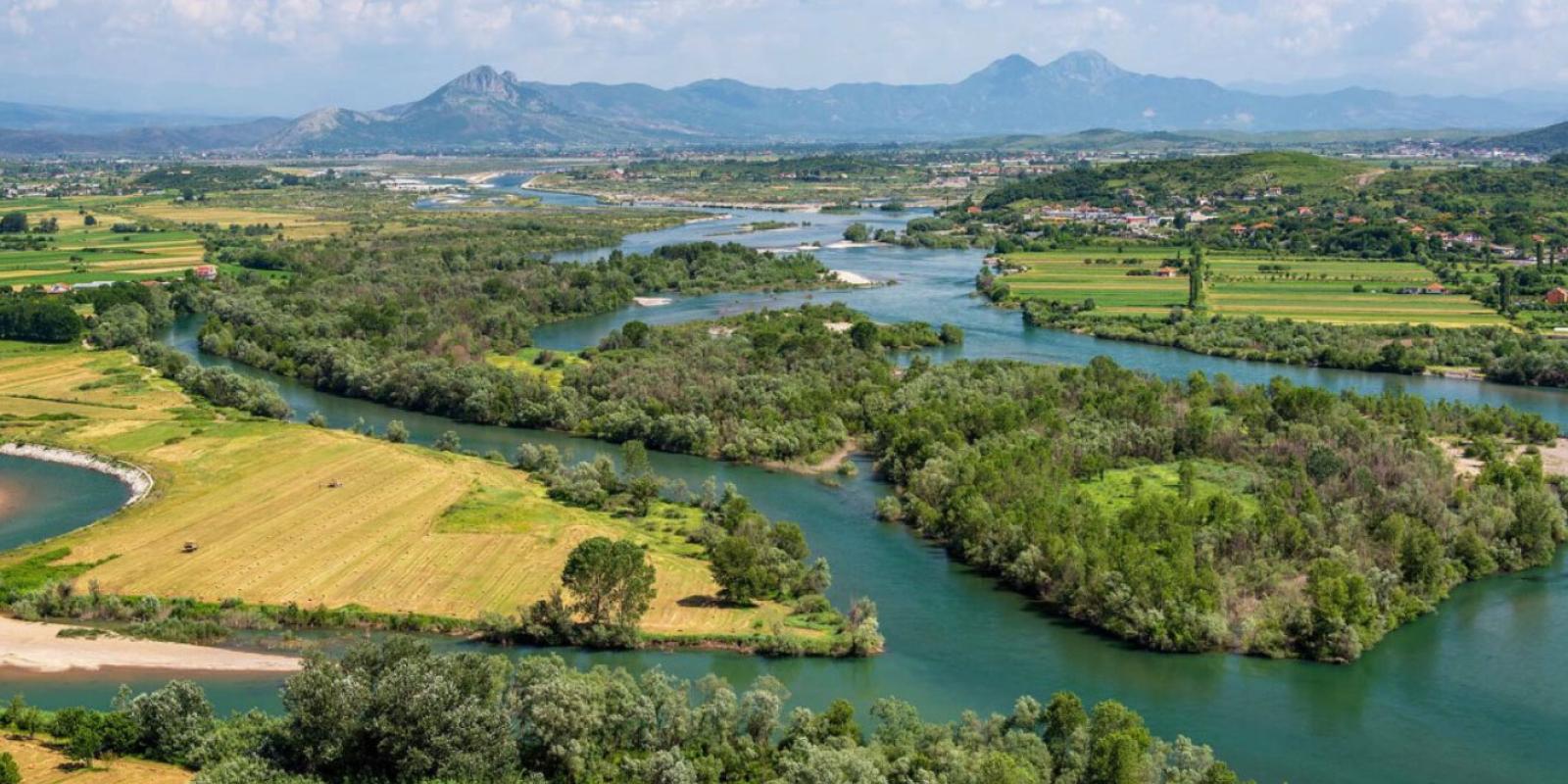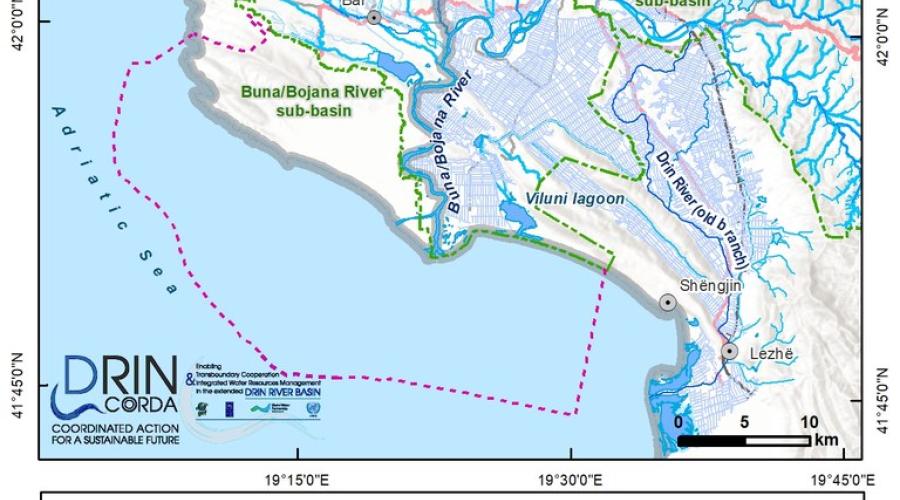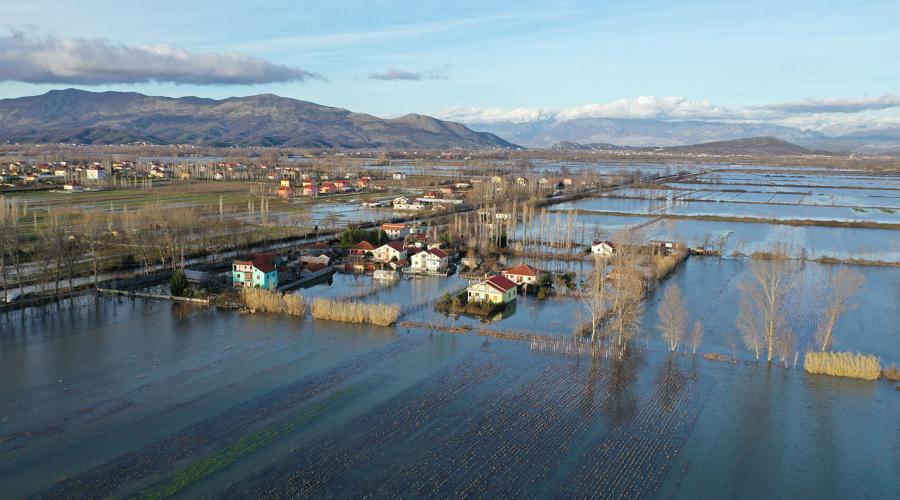
The Buna/Bojana river surges from the Shkodra/Skadar lake and flows to the Adriatic Sea, initially through Albanian territory, and subsequently forming the border between Albania and Montenegro. The total length of the river is 41 km. Along its meandering flow into fields and marshlands, the Buna river receives its most important tributary, Drin, the longest river in Albania (280 km), with a catchment area extending to the 6 Western Balkan countries (and inhabited from up to 1,6 million people). The Drin river contains the largest hydroelectric power station group in the Balkans regarding the installed and reservoir capacity, therefore heavily influencing the Buna sub-basin, where it flows.
The research does not only cover the whole length of the Buna river, but extends to the watershed area of approx. 5,187 km2, and a population of approximately 10,000 inhabitants, including the tourism hub of Velipoja, rural settlements along Buna, etc. The city of Shkodra, with a population of more than 150,000 inhabitants, is not situated within the Buna sub-basin, but will still be one of the target areas of the research. Moreover, settlements across the Montenegrin border will be considered in a second stage, such as the city of Ulcinj and villages of Freskanjel, Shënkoll, etc, with a population of up to 20,000 inhabitants.
Rationale
The Buna sub-basin is a very vulnerable ecosystem for many reasons. Firstly, it forms a very fertile and productive delta, which has secured the livelihood of northern inhabitants for centuries. This delta is currently assigned a protected status (protected landscape, 5th category), yet there is no proper management plan in place, and biodiversity is under loss.
Secondly, the Buna river is one of the most polluted riverine ecosystems. This pollution is mainly transmitted from the whole watershed area of Drini, surging from Prespa lake. However, some sources of pollution include poor solid waste and wastewater management in the municipality of Shkodra, and chemical pollutants from agriculture uses. The effect of this pollution is transmitted throughout the whole Adriatic coast in the north of the Balkans.
Thirdly, the Buna Delta is one of the most vulnerable areas to flooding in the whole of the Mediterranean when it comes to climate risk. During a storm or a flood event, the water can reach and retain a height of up to 5 meters.
Fourthly, there are many competing land-uses within the watershed area, reflecting discrepant expectations for sectorial growth: extended tourism activities in Velipoja city; protection of riparian area and natural landscape; and extensive agricultural production. The balance between these activities is not achieved, yet there is a regional perspective to turn the area into an eco-tourism destination.
Lastly, the social vulnerability is very prominent. While citizens of Shkodra are acknowledged for their positive attitude towards community and heritage protection, the behaviour in the rural area close to Buna does not reflect this. Illegal fishing; use of harmful fertilizers, informal construction; deforestation; informal wastewater discharges; etc. are all anthropocentric interventions that can, with time, cause unrecoverable degradation of the landscape. This comes from lack of awareness and uncollaborative decision-making.
Strategy
Our strategy of intervention is relevant for governance stakeholders and local communities. Governance stakeholders will be provided with an evidence-based assessment of ecosystem services within the Buna sub-basin, to inform multi-level decision-making for different policies, i.e. spatial planning, biodiversity protection, risk management, tourism development, water management, and cultural heritage preservation. The local community, including farmers, small business owners, tourism operators, and local households will be engaged throughout the research as citizen scientists, co-assessing ecosystem services and co-designing the methods, and strategies for intervention that should be prioritized accordingly. These ecosystem services include: 1) provisioning services: agriculture and fishery; 2) cultural services: tourism and recreation; 3) regulating services: water purification, erosion, and flood control, and carbon sequestration; 4) supporting services: maintenance of biodiversity.
This process aims to empower the local community, transfer knowledge that is sustained and anchored to them through participation in scientific processes; and support collaboration in decision-making.
The process will be replicated in the Montenegrin territories, and a comparative overview of findings in terms of territorial and societal features will be designed, to support better cross-border cooperation and governance.
Methods
Our research scope is to engage local communities in co-assessing ecosystem services provided by the Buna River ecosystem, while encouraging horizontal and vertical collaboration between governance and other local stakeholders in designing a joint action plan for its enhancement. This citizen science activity will include farmers, fishermen, providers of tourism activities, recreational / accommodation business owners, and inhabitants. The approach is significant for many reasons:
- Firstly, while there are many initiatives aiming at restoring, mapping, and studying the Buna delta, there is no real effort in mobilizing local communities to partake in decision-making.
- Secondly, by assessing ecosystem services in this sub-basin, the researchers will be providing a very robust tool for evidences that help informed decision-making/visioning and strategy development for the future of the area, especially in the context of climate change.
- Thirdly, through citizen science, local communities will enhance their own knowledge of the lagoon, set their preservation priorities; and induce behavioral change in the society as a whole.
The case study will provide a thorough methodology on replication of the Ecosystem Service Assessment methods, and with a Guideline on how to mobilize communities in Citizen Science. These approaches may be useful for other researchers within RCN, and beyond, since all the designed and implemented research activities will be set up in an open, accessible knowledge platform, available to all.





